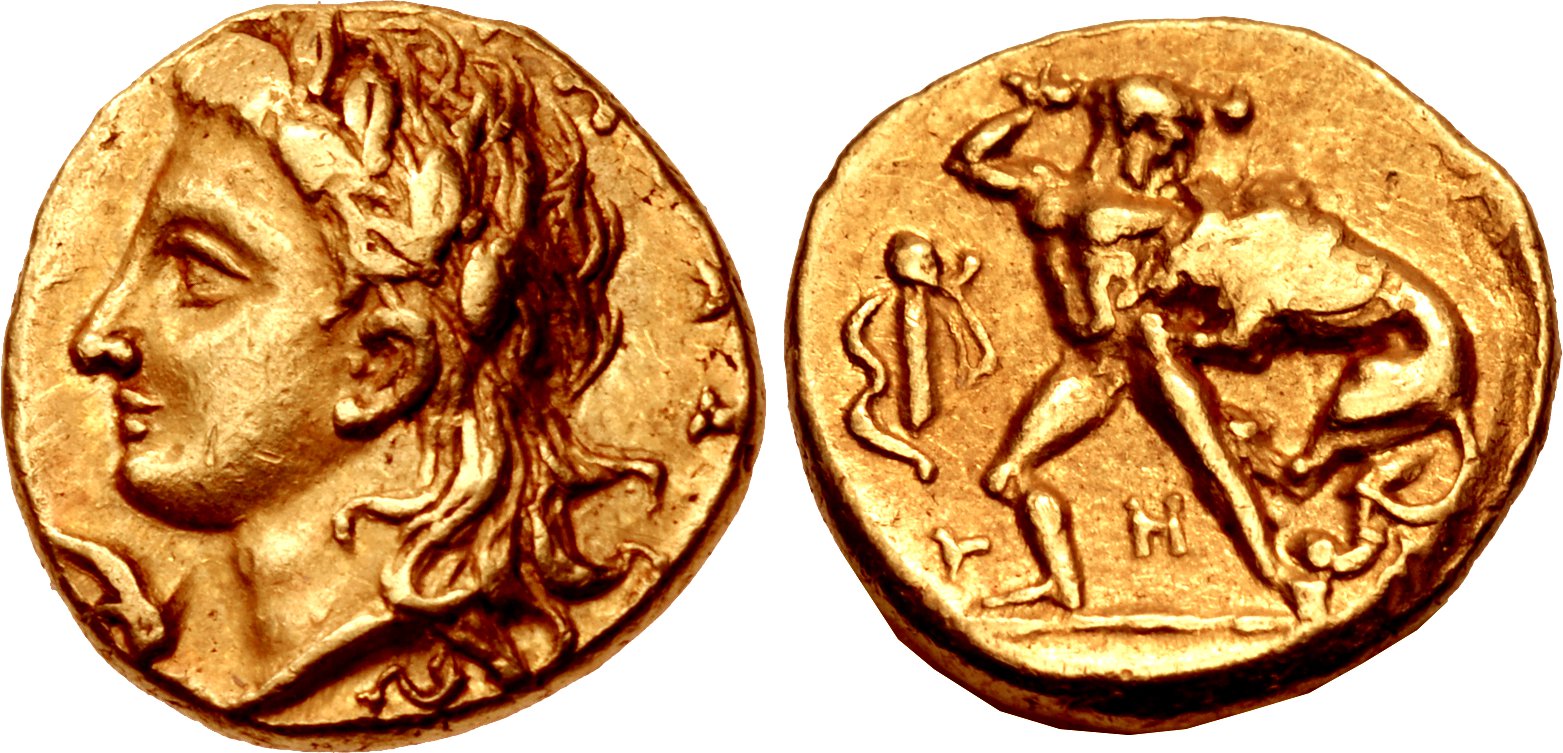Taras, gold, diobols (1/6th staters) (320-315 BCE)
From SILVER
320 BCE - 315 BCE Gold 532 kg
Description
| ObverseInscription or printing placed on the obverse.: | TAPAΣ (Greek).Head of Apollo left, wearing laurel wreath, and dolphin to left |
| ReverseInscription or printing placed on the reverse.: | Herakles, raising club overhead in right hand, preparing to strike the Nemean lion as it attacks him from the right, bow and quiver to left, H below |
Mint and issuing power
| MintIdentifies the place of manufacture or issue of a numismatic object.: | Taras | Ancient regionAncient region.: | Calabria | Modern countryModern country: Italy | AuthorityIdentifies the issuing power. The authority can be "pretended" when the name or the portrait of X is on the coin but he/she was not the issuing power. It can also be "uncertain" when there is no mention of X on the coin but he/she was the issuing power according to the historical sources: |
Chronology
| FromIdentifies the initial date in a range assigned in a numismatic context. | 320 BCE | toIdentifies the final date in a range assigned in a numismatic context.. | 315 BCE | PeriodTime period of the numismatic object.: Hellenistic 323-30 BC |
Physical description
| MetalThe physical material (usually metal) from which an object is made.: | Gold |
Median weightMedian of the weights of numismatic objects (in grams). in grams | 1.40 | DenominationTerm indicating the value of a numismatic object. Examples: tetradrachm, chalkous, denarius.: | diobol |
StandardStandard.: |
Image

S845 Taras sixth staters.jpg [1]
References
| Die study referencePublication of the study: | Fischer-Bossert 19991Fischer-Bossert 1999, p. 351-356, G8 and G14. | ||
| Coin series referenceReference to coin series study: | |||
| Coin series web referenceCoin series web references: | |||
Obverse dies distribution
| FrequencyFrequency of specimen in distribution. ᵖ | Number of obversesNumber of obverse dies. ᵖ (o) | % (o) | Number of coinsNumber of coins. (n) | % (n) | Die nameName(s) of the die(s). |
| 19 | 1 | 50 | 19 | 19.39 | 7 |
| 79 | 1 | 50 | 79 | 80.61 | 11 |
| Total | 2 of 2 | 100 | 98 of 98 | 100 |
Reverse dies distribution
| FrequencyFrequency of specimen in distribution. ᵖ | Number of reverse diesNumber of reverse dies. (r) | % (r) | Number of coinsNumber of coins. (n) | % (n) | Die nameName(s) of the die(s). |
| 19 | 1 | 50 | 19 | 19.39 | 8 |
| 79 | 1 | 50 | 79 | 80.61 | 14 |
| Total | 2 of 2 | 100 | 98 of 98 | 100 |
Quantification
| Number of obversesNumber of obverse dies. ᵖ (o) | 2 | Number of singletons (o1)The number of singleton coins. ᵖ | |
| Number of reverse diesNumber of reverse dies. (r) | 2 | Number of coinsNumber of coins. (n) | 98 |
| Coins per obverse dieNumber of coins per obverse die. (n/o) | 49 | Coins per reverse dieNumber of coins per reverse die. (n/r) | 49 |
| Reverse per obverse ratioRatio of obverse dies divided by reverse dies. (r/o) | 1 | Percentage of singletons (o1)number of coins (n) divided by the number of singletons (o1) ᵖ | % |
| Original number of dies (O) (Carter 1983 formula)The estimation of the number of coins according to Carter 1983 ᵖ | 1.9 | Coins struck if 20,000 as average productivity per dieCoins made if the average productivity for obverses (according to Carter) is 20,000. ᵖ | 38,000 |
| Original number of dies (O) (Esty 2011 formula)The estimation of the number of coins according to the singleton formula in Esty 2011 ᵖ (O) | 2.04 | Survival rate if 20,000 as average productivity per dieSurvival rate if average productivity is 20,000. ᵖ | 0.00258 |
| Coverage (o = % of O) (Esty 1984 formula)Esty 1984 - coverage (% of O) ᵖ (o = % of O) | % | Die productivity if survival rate 1/2,000Average productivity if survival rate is 1/2,000. ᵖ | 103,157.89 |
| Weight of silver (in kg) if 20,000 coins per die (O = Carter formula)Carter 1983 * Median weight * 20000 (*10 if gold or electrum) ᵖ | 532 kg <br /> 532 kg | Die productivity if survival rate 1/5,000Average productivity if survival rate is 1/5,000. ᵖ | 257,894.74 |
Remarks
Most likely one single workstation